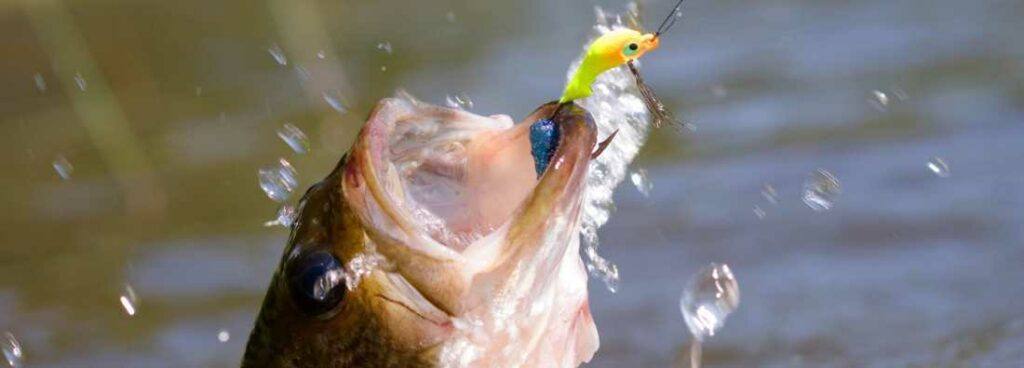Stories Worth Reeling In...
Last Updated on September 18, 2023
Fishing for bass on rocks might be difficult, but it also has some exciting benefits. Fishing is a popular sport in America, and bass fishing is one of the most popular. It’s a terrific way to spend time outside, relax, and attempt to catch a big one! This article will teach you all you need to know to start rock fishing for bass.
Table of Contents
Bass is a renowned game fish noted for their fighting spirit and exquisite flavor. They can be found in freshwater lakes, rivers, and streams, and they are particularly fond of stony structures. Rocks are used by bass for cover, ambush positions, and food hunting.
To catch bass on rocks, you must first understand their habits and the kind of rocks they favor. The ideal time to catch bass on rocks is during the warmer months, from spring to October. Bass are very active on rocks at dawn and dusk.
Rock fishing requires specialized equipment and tackle to be successful. You’ll need a good fishing rod, reel, fishing line, lures, and hooks. Consider the type of rocks you’ll be fishing and the conditions you’ll be confronting while selecting your gear.
For example, if you’re fishing in fast-moving water, you’ll need a robust rod and reel to handle the stream. The appropriate equipment will make a significant difference in your fishing results.
When fishing for bass on rocks, the best lures mimic the bass’s natural prey. These lures include crankbaits, jigs, soft plastics, and spinnerbaits. The lure used will be determined by the fishing conditions and the behavior of the bass in the area, so make sure to experiment with different lures to see what the fish are biting on.
You must use a different technique when fishing for bass on rocks than when fishing in open water. Casting, retrieving, and fishing line tactics, among others, help catch bass on rocks.
To begin, you must find and target bass on rocks. Look for rocks near drop-offs, underwater ledges, and current zones. Bass frequently use these places to look for food and find cover.
Once you’ve located a suitable location, you must read the water and choose the best manner to deliver your bait.
When fishing on rocks, proper casting skills are essential. You’ll need to make precise casts to reach the bass and avoid snagging your line on rocks. Retrieve tactics are especially important when capturing bass on rocks.

Changing your retrieve speed and style can elicit a strike from a bass.
When fishing on rocks, using the proper fishing line, such as fluorocarbon or braided line, can aid in detecting bites and avoiding snagging.
Weather conditions also impact your results when fishing on rocks.
Topwater lures can successfully simulate prey attempting to flee from the surface on sunny days.
Last but not least, it’s critical to utilize lures that resemble the color of the local baitfish during low-light circumstances, such as dawn or twilight.
Rock fishing can be difficult, and there are some frequent errors that novice rock fishermen make.
Snagging your line on rocks is one of the most common mistakes. Make accurate casts and keep track of where your line is to avoid this. Another common blunder while fishing on rocks is losing lures.
Ensure your hooks are sharp and your knots are tight to prevent this. Spooking fish is another typical issue when fishing from rocks.
Avoid spooking fish by making as little noise as possible and approaching the fishing area slowly and silently.

Another issue while fishing from rocks is dealing with strong currents or deep water. It’s critical to use heavier gear and alter your retrieve speed appropriately in these instances.
Finally, fishing in murky water might be challenging because it is difficult to see your line and lure. Try utilizing brighter lures or adding an attractant to your bait in these cases.
A jig with a weedguard is versatile for bass fishing around rocks because it can effectively entice bass hiding in cover without getting snagged, making it an ideal lure choice.
When bass are actively feeding on crawfish, it’s advisable to use crawfish-imitating colors like brown-and-orange, brown-and-green pumpkin, or black-and-blue for both your jigs and soft plastic trailers.
On cloudy days with a slight breeze, you can trigger aggressive bass to strike your jig by employing an active approach, such as hopping the jig or banging it into the rocks.
During calm, sunny days when bass tend to hug the rocky bottom, it’s effective to crawl a football jig over the rocks using short pulls of your rod. Pause the lure for a few seconds to coax lethargic bass into biting.
Fluorocarbon line is recommended for throwing jigs around rocks due to its increased sensitivity and abrasion resistance. It helps anglers distinguish between a bass engulfing the jig and the jig hitting a rock, while also minimizing line nicks caused by constant contact with rocks.
Finally, rock fishing for the bass may be a fun and gratifying experience. You can improve your chances of success by learning about bass behavior and habitat, selecting the correct equipment and tackle, and perfecting techniques for fishing on rocks.
You may also make the most of your time on the water by being aware of frequent mistakes and trying to avoid them.
Accept the joys and rewards of this great hobby, and get out there to try it!